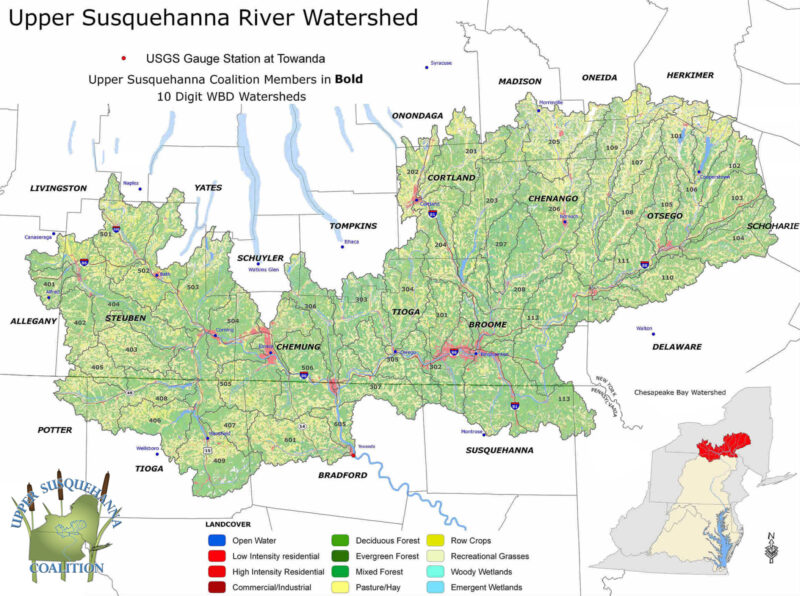About the Upper Susquehanna Coalition
USC Structure: The Upper Susquehanna Coalition (USC) consists of 22 Soil and Water Conservation Districts (18 in NY and 4 in PA) that cover 99% of the headwaters of the Susquehanna River upstream of Towanda, PA. USC Watershed Statistics are as follows:
- 7,500 square miles
- 13,000 miles of roads and 17,000 miles of stream
- 69% forest, 23% agriculture, 3% urban/suburban, 4% open water/wetlands
The USC was established in 1992 to work on quality issues in the headwaters of the Chesapeake Bay. In 2006 we transitioned to a coalition of Conservation Districts using a Memorandum of Understanding (MOU) based on NY and PA state law. These state laws allow Districts to enter into multi-District agreements in legally binding agreements. The Tioga County Soil and Water Conservation District is the MOU designated USC Administrator, responsible for all contractual and other legal obligations.

Vision
A well functioning Susquehanna River Headwaters in harmony with itself and the entire Chesapeake Bay Watershed.
Mission
To protect and improve water quality and natural resources in the Upper Susquehanna River Basin with the involvement of citizens and agencies through planning, education, coordination, funding, project implementation and advocating for our water resources.
An Integrative, Multiple Barrier Approach
The Upper Susquehanna Coalition (USC) has developed a “Multiple Barrier Approach” (MBA) for planning and implementing restoration projects on a watershed basis. The MBA addresses the issue at the source (e.g., headwaters), across the landscape, and in the stream corridor, as well as programmatically (e.g., regulations, training, protection). By developing multiple projects to address problems, progress can continue and tangible results achieved even with smaller funding levels. Multiple barriers can increase the probability of success and help capture stakeholder interest by demonstrating progress through implementation. A successful Multiple Barrier Approach relies on a firm understanding of how each watershed functions in relation to its hydrologic characteristics, drainage patterns, topography, land cover, land uses and misuses, precipitation events and other parameters. Flooding, streambank erosion, gravel deposition and nutrient loading are common problems in the USC Basin and priority USC issues.
The USC has developed three focus areas:

1. Environmentally and Economically Sustainable Agriculture
A primary goal of the USC is to support “Environmental and Economically Sustainable Agriculture.” We define this as documenting farm statistics and BMPs, developing watershed and site specific agricultural plans and implementing and evaluating practices. We use the NY Agricultural Environmental Management Program approach for evaluating our farms and follow the Chesapeake Bay Program’s approach for Best Management Practice information. Agricultural Practices that have important economic and environmental benefits include:
- Riparian Forest Buffers
- Riparian Grass Buffers
- Nutrient Management Plans
- Stream Protection with Fencing and off-site watering
- Prescribed Grazing Systems
- Animal Waste Management Systems
- Barnyard Runoff Control Systems
- Conservation Till
- Highly erodible agricultural land retirement
- Tree Planting
- Cover Crops
- Conservation Plans
- Alternative uses of Manure
- Precision Feed and Forage Management for Dairy
- Horse Pasture Management
2. Stream Corridor Rehabilitation
Stream Corridor Rehabilitation includes natural stream design techniques, stream rehabilitation and stabilization, floodplain enhancement and buffers (buffers are components of all 3 focus areas) that we generally think about in the flooding/erosion arena. The problems associated with streams are many, usually large and can be expensive. We have developed a USC Stream Team, to provide technical expertise and training to USC members.
Steam Team’s guiding principles:
- Stream issues will be approached on systemic manner considering whole watershed condition and impact
- When possible, stream issues will be monitored to determine rate and status of observed or perceived impairments
- Stream issues will be approached with a restoration objective as opposed to a stabilization approach where possible
- Restoration includes consideration of geomorphic, hydrologic, habitat, water quality, riparian, social and economic values
- Stream issues will be approached in a pragmatic manner with the realization that funding, materials and other resources are limited
- The education of landowners, municipal officials, maintenance personnel, land use planners, etc. is of primary importance
- in order to effect cultural change in how we manage our streams and watersheds
- Creative, cost effective approaches to stream restoration is encouraged in management, regulation and actual in channel work
- Information learned in our region regarding stream restoration (what works and what doesn’t work) will be shared and networked
- Local empowerment through education, training, actual experience, etc. is a primary objective (use of local designers, contractors, material suppliers)
- Further research of regional stream system elements is needed to better understand the complexity of our local streams
3. Wetland Restoration
Wetland Restoration includes restoration, construction, conservation, protection and research with our partners. The USC has filled a relatively unoccupied niche and is largely carried out by specialized USC staff. We are “vertically and horizontally integrated” with equipment, staff and partners to address, participate in and implement any type of wetland project.
The USC Wetland Program has three major goals:
- Attenuate Floods: Wetlands, especially in the headwaters of a watershed, through their water holding capabilities and vegetation, can desynchronize rainfall runoff events, thus reducing flood peaks and downstream erosion. Novitzki (1985) found that a watershed with about five percent wetlands could have a 50 percent reduction in peak flood flows compared to a watershed that had none.
- Enhance Water Quality: Wetlands retain sediment and nutrients during rainfall events and can be an important nutrient and sediment sink.
- Increase Wildlife and Habitat Diversity: Wetland complexes provide unique habitats that increase species diversity and habitat connectivity.
